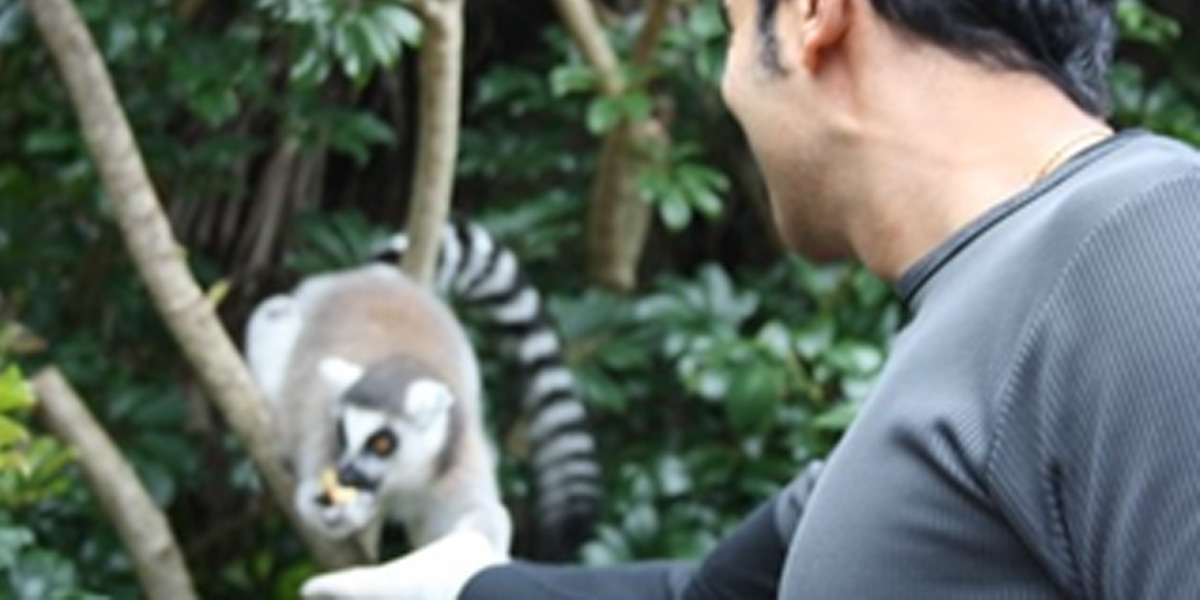HomeAnti-aging, Skin Cancer, Skincare
An orange a day may make your doctor go away.
February 3, 2023
 As a skin cancer expert, and someone with an interest in evolutionary biology, I am often asked to operate on animals or treat skin diseases on amazing creatures. The picture to the left shows me examining a lemur (it had a tumour on its tail). Lemurs—precursors of modern primates—can produce their own vitamin C. In contrast, Squirrel monkeys –-New World monkeys of the genus Saimiri—cannot, and studies have shown that squirrel monkeys can develop vitamin C deficiency in captivity if fed commercial processed diets. Here is another picture of me, this time with a squirrel monkey, coaxing a patient close enough to examine his skin (with his family keeping an eye on things)!
As a skin cancer expert, and someone with an interest in evolutionary biology, I am often asked to operate on animals or treat skin diseases on amazing creatures. The picture to the left shows me examining a lemur (it had a tumour on its tail). Lemurs—precursors of modern primates—can produce their own vitamin C. In contrast, Squirrel monkeys –-New World monkeys of the genus Saimiri—cannot, and studies have shown that squirrel monkeys can develop vitamin C deficiency in captivity if fed commercial processed diets. Here is another picture of me, this time with a squirrel monkey, coaxing a patient close enough to examine his skin (with his family keeping an eye on things)!

The chart below shows the animals that can produce their own vitamin C in bold black letters. The animals listed in grayscale letters need vitamin C in their diet. Some primates such as gorillas eat as much as 20-30 mg/kg/day and bats consume 258 mg/kg/day of vitamin C by gorging on fruits containing the vitamin.

Evolutionary changes may be major epochal productions, planned thousands of years in advance but they exhibit a simple truism that has become a Darwinian dictum: “Use it, or lose it.” Man and primates cannot produce their own vitamin C because, as scientific stories suggest, they started eating fruits containing vitamin C. Hence humans must eat enough vitamin C to satisfy our body’s daily requirement or risk disease as our bodies don’t produce any.
Interestingly, human babies in the womb can produce some vitamin C, and hence have great wound healing capacity, but lose this ability after birth. The beneficial effects of vitamin C on skin and wound healing are well known as in my skin research lab we make vitamin C serums (I shall save this discussion about skin and vitamin C for another time).
In 1497, Vasco Da Gama, the Portuguese circumnavigator lost 100 out of 160 seamen on his expedition to India due to a mysterious disease. It would take more than two centuries before the cause of this fatal disease, scurvy, was identified as being due to a lack of vitamin C. Scurvy makes one tired and lethargic, followed by formation of spots on the skin, spongy gums, and bleeding from mucous membranes. Soberingly, scurvy killed more than 2 million sailors between the 16th and 18th centuries alone!
In 1747, James Lind, a naval surgeon aboard the HMS Salisbury conducted one of the earliest double-blind trials in medicine,. Lind took twelve men with similar cases of scurvy — as he noted, “… their cases were as similar as I could have them” — and gave half two oranges and one lemon per day; the others, he gave vinegar and seawater. Only the men that ate the oranges and lemons survived and were able to get back to their duties at sea.
In a medical textbook written in 1820, another naval surgeon Usher Parsons described the signs of scurvy: “The gums become soft, livid and swollen, are apt to bleed from the slightest cause, and separate from the teeth, leaving them loose. About the same time the legs swell, are glossy, and soon exhibit foul ulcers. The same appearances follow, on other depending parts of the body … Emaciation ensues.”
In researching for my book, The Genetics of Health (Simon and Schuster, NY), I became interested in how individuals metabolize different nutrients differently, and ended up developing a 70-gene test to help people eat for their gene type. When studying the genetic variations behind vitamin C metabolism specifically, I noted the importance of the GSTT1 gene which produces proteins for the glutathione S-transferase enzyme family. These enzymes play a key role in the utilization of vitamin C. The GSTT1 gene exists in one of two forms. The insertion (Ins) form is considered functional, while the deletion (Del) variant is faulty. People who possess this Del version will have lower blood levels of vitamin C even if they eat the same number of oranges and lemons as other people. In other words, these people need to eat much more than the usual amount of vitamin C.
In those seafaring days, when so many lives were lost to scurvy, Lind’s study showed the importance of vitamin C, not just for gum health but as a powerful anti-oxidant that can protect the heart, kidney, skin and other major organs. But adding genetic profiles into the mix allows scientists like me to take a Lind-like study to the next level of scientific sophistication.
What happens if someone with a Del variant does not increase vitamin C intake? Indeed a study to answer this question was done on young Canadian students. These were students in their 20s and 30s and the study looked at the GSTT-1 gene, and the long term effects of having a non-functional vitamin C gene. Studies showed a raised risk of blood pressure, higher sugar levels and risk of heart disease (and these were young people!) demonstrating the risk of having a non-functioning vitamin C gene over time progressively increases the risk of heart disease and diabetes! Studies were repeated in Asian students with the same results i.e. the bad version of the vitamin C gene exists across different ethnic groups, and in addition to the diseases mentioned earlier, also makes people gain weight and have larger waistlines. The chart below illustrates these increased risks.
 If you want to find out your own gene type, you can order a test here. People with this Del variant need to take additional amounts of vitamin C in their diets, and recommendations will be in the report. For such people eating an (extra) orange a day may indeed keep the doctor away! Peppers are also a good source of vitamin C as some yellow peppers have more vitamin C than an orange. In fact, my book The Genetics of Health has a detailed chapter on the topic titled “Eating for Your Gene Type”.
If you want to find out your own gene type, you can order a test here. People with this Del variant need to take additional amounts of vitamin C in their diets, and recommendations will be in the report. For such people eating an (extra) orange a day may indeed keep the doctor away! Peppers are also a good source of vitamin C as some yellow peppers have more vitamin C than an orange. In fact, my book The Genetics of Health has a detailed chapter on the topic titled “Eating for Your Gene Type”.
Written By
Dr Sharad Paul
Dr Sharad Paul is an award winning, world renowned recognised skin-cancer expert and thought-leader.






